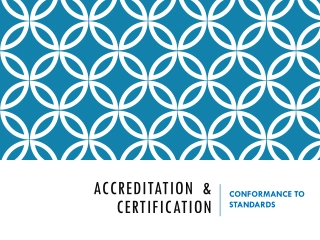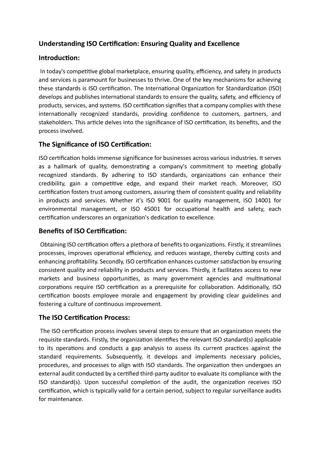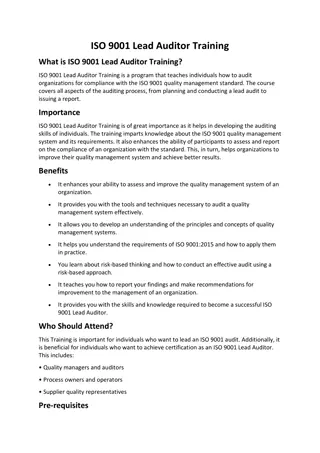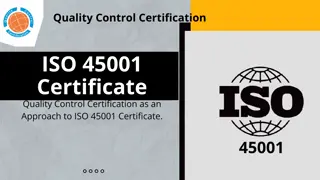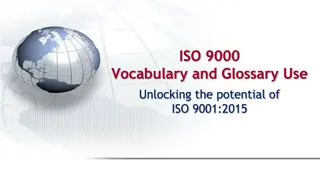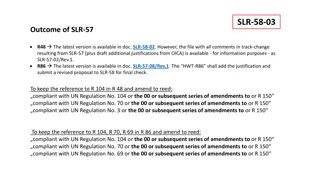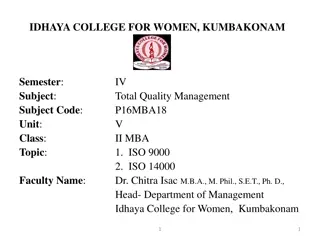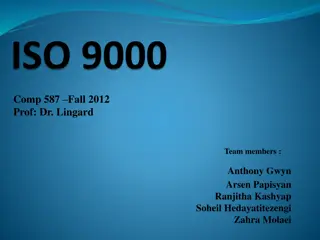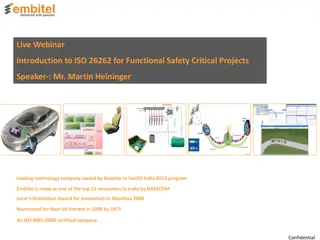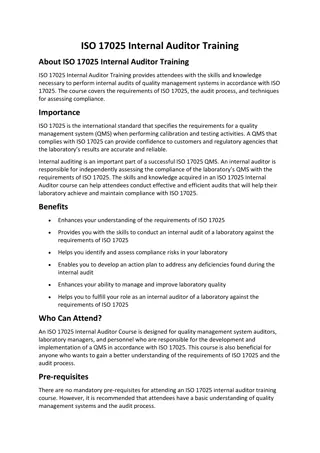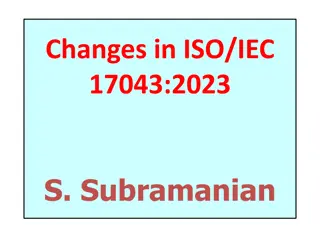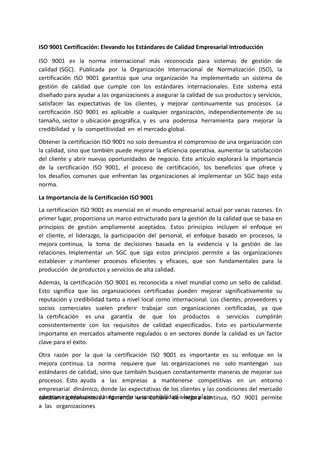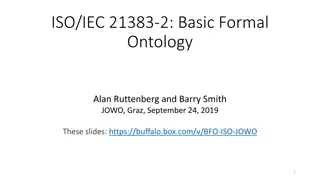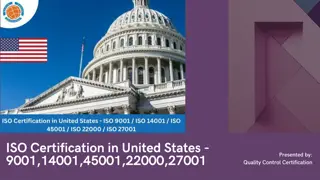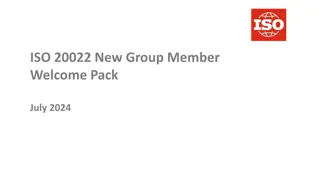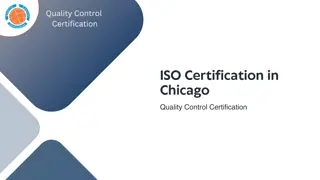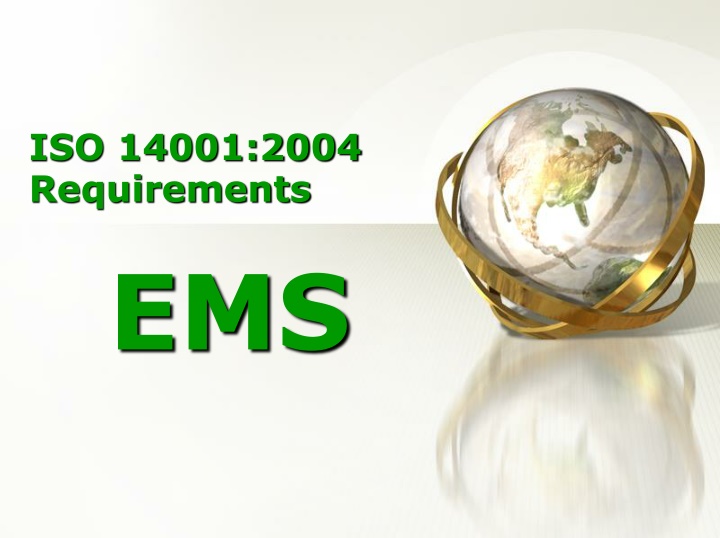
ISO 14001:2004 Requirements for Environmental Management Systems
Explore the essential requirements of ISO 14001:2004 standard for Environmental Management Systems (EMS). Dive into topics like initial environmental review, assessment of significant aspects, and the relationship between population, consumption, and environmental impacts. Discover strategies for environmental protection, effective management, and waste reduction. Learn about the importance of involvement, design, efficiency, and monitoring in the 21st century. Gain insights into different approaches in environmental management such as source reduction, waste recycling, and treatment. Discover the hierarchy of environmental management practices to enhance sustainability and resource efficiency.
Download Presentation

Please find below an Image/Link to download the presentation.
The content on the website is provided AS IS for your information and personal use only. It may not be sold, licensed, or shared on other websites without obtaining consent from the author. If you encounter any issues during the download, it is possible that the publisher has removed the file from their server.
You are allowed to download the files provided on this website for personal or commercial use, subject to the condition that they are used lawfully. All files are the property of their respective owners.
The content on the website is provided AS IS for your information and personal use only. It may not be sold, licensed, or shared on other websites without obtaining consent from the author.
E N D
Presentation Transcript
ISO 14001:2004 Requirements EMS
Course Outline Introduction to EMS Requirements of ISO 14001:2004 standard Initial Environmental Review Assessment of Significant Aspects
Course Outline Introduction to EMS
RELATIONSHIP BETWEEN POPULATION, CONSUMPTION AND ENVIRONMENTAL IMPACTS x = Global population Per capita consumption Global Environmental Impact Environmental Technology
Environmental protection in the past 30 years End of pipe treatment Focus on manufacturing and industrial sector Economic and Environmental objectives in conflict Legal control more than voluntary compliance
What do we need in the 21st century? Think system Involvement of all staff Design for productivity Consider efficiency of energy and raw materials Monitoring of growth (i.e. business expansion) Government incentives/flexibilities Prevention Support from management level Voluntary self compliance
Environmental Management can be done through: source reduction source reduction waste reduction waste reduction waste recycling waste recycling treatment treatment
Hierarchy of environmental management SOURCE REDUCTION Don t buy it! End product redesign, Hazardous chemical substitution, Hazardous chemical modification, Purchasing and inventory control, best Management practice and good housekeeping WASTE REDUCTION Don t waste it! Benchmarking, employee training, maintenance, process control Process modification and equipment modification WASTE RECYCLING Don t throw it away! Closed loop recycling, waste segregation, reuse waste, reclaim waste TREATMENT Turn waste into resources! Convert waste into new products, find outside users for wastes
What is ISO? ISO - International Organization for Standardization Non-Governmental organization Began its official functions on February 23, 1947 ISO from Greek word ISOS meaning equal
Mission of ISO: Promotion of the development of standardization and related activities in the world with a view to: Facilitate the international exchange of goods and services Develop cooperation in the spheres of intellectual, scientific, technological and economic activity
Rationale for the EMS EMS when integrated with other management systems (i.e. QMS), can help achieve environmental and economic goals Enables the organization to develop and implement a policy and objectives which take into account legal requirements and information about significant environmental aspects. Provides the framework for continual improvement on environmental objectives and targets.
What's in it for me? Improved company credibility Competitive advantage in the market place Reduced trade barrier Satisfy stakeholders interest
What's in it for me? Reduced raw material usage Reduced energy consumption Reduced waste disposal cost Recoverable resources Reduced penalties and insurance premium Continuity of operation and increased efficiency Fewer accidents
ISO 14000 Family of Standards ISO 14001:2004 ISO 14004:2004 ISO 19011:2002
ISO 14001 specifies requirements for an environmental management system to enable an organization to develop and implement a policy and objectives, and information about significant environmental aspects.
ISO 14004 Provides organizations requiring more general guidance on a broad range of EMS issues.
ISO 19011 provides guidelines on auditing quality and environmental management systems.
The purpose of ISO 14000 standards Reduced pollution and negative effects Improved utilization of resources Does not replace legislative and regulatory requirements Does not specify environmental performance criteria Q ACF
ISO 14001:2004 STANDARD REQUIREMENTS
The scope of ISO 14001 standard CLAUSE # DESCRIPTION 1 2 3 4 4.1 4.2 Scope Normative Reference Terms & Definitions Environmental Management System Requirements General Requirements Environmental Policy
The scope of ISO 14001 standard CLAUSE # DESCRIPTION 4.3 4.3.1 4.3.2 4.3.3 PLANNING Environmental aspects Legal and other requirements Objectives, targets and programme(s)
The scope of ISO 14001 standard CLAUSE # DESCRIPTION 4.4 OPERATION 4.4.1 and authority 4.4.2 4.4.3 4.4.4 4.4.5 response IMPLEMENTATION AND Resources, roles, responsibility Competence, training and awareness Communication Operational control Emergency preparedness and
The scope of ISO 14001 standard CLAUSE # DESCRIPTION 4.5 4.5.1 4.5.2 4.5.3 preventive action 4.5.4 4.5.5 4.6 CHECKING Monitoring and Measurement Evaluation and Compliance Nonconformity, corrective action and Control of Records Internal audit Management Review
EMS Model Environmental Policy Continual Improvement Management Review Planning Implementation & Operation Checking
EMS Implementation Cycle Environmental Policy Organization & Personnel Mgt Review Regulations, aspects & impacts EMS Audits Objectives & Targets Records Management Programs Operational Control Management Procedures
What does an EMS do? Establishes the EMS Policy, Objectives and Targets Prevents problems rather than fixing them later Provides evidence of compliance Makes effort for continual improvement
EMS Needs Means / methods Resources Training Time frame Documentation / reporting Communication Operational control
1 Scope Applicable to any organization that wishes to: a. establish an EMS b. assure itself of conformity with its stated environmental policy c. demonstrate conformity by: 1. making a self-determination and self-declaration 2. seeking confirmation of its conformance 3. seeking confirmation of its self-declaration by external party 4. seeking certification/registration
2 Normative reference No normative references are cited. This clause is included in order to retain clause numbering identical with the previous edition (ISO 14001:1996).
4.1 General Requirements Establish, document, implement, maintain and continually improve an environmental management system Define and document the scope
4.2 Environmental Policy Appropriate to the nature, scale and environmental impacts of activities, products and services. Include a commitment to continual improvement and prevention of pollution. Include a commitment to comply with applicable requirements and with other requirements to which the organization subscribes which relate to its environmental aspects Provide the framework for setting and reviewing environmental objectives and targets. Is documented, implemented, maintained Is communicated to all persons working for or on behalf of the organization Is available to the public
Environmental Policy It is the policy of Company ABC to conduct all business activities in the manufacturing of Coils, Coil Assemblies and Integrated Molds in a responsible manner for the protection and preservation of the environment. ABC is committed to comply with all applicable environmental legal and other requirements. Reviewing its products, activities, environmental objectives and targets for the conservation of resources, prevention of pollution for continual improvement.
Writing the Policy Should reflect top management s commitment to comply requirements, prevention of pollution and continual improvement Area of application should be identified Forms the basis for setting the objectives and targets Easy to understand by interested parties
The Policy should be: Communicated to all persons who work for, or on behalf of, the organization. Including contractors working at an organization s facility. Defined and documented by its top management
4.3 Planning Environmental Aspects Definitions: Environmental Aspects: an element of an organization s activities or products or services that can interact with the environment. Environmental Impact: any change to the environment, whether adverse or beneficial, wholly or partially resulting from an organization s activities, products or services.
4.3 Planning 4.3.1 Environmental Aspects Establish, implement and maintain procedure(s) to: a.identify environmental aspects of its activities, products and services within defined scope of the EMS b.determine those aspects that have or can have significant impact(s) on the environment
Environmental problems Global warming Stratospheric Ozone depletion Acid rain Water quality Air quality Noise / vibration Visual impact Waste management Contaminated land Major spills and incidents Release of genetically manipulated organisms
Issues for the industry Air pollution Water pollution Water usage and other resource usage Hazardous substances Biological hazards Radiation Waste Noise Community concerns Wildlife and habitats Accidents and emergencies Interface with other heath and safety issues
Aspects normal, abnormal, emergency Air Emissions Liquid releases Waste management Land contamination Use of materials and resources Noise, odor, dust, vibration, visual impact Eco systems aspects Transport / contractors Other
Identification of aspects - Tools Product review (Life cycle analysis) Site assessment Product/process data review Communications review Compliance audit Walk through audit Past performance review Referred to as Initial review or Preparatory Environmental Review (PER)
What should be considered in identifying the environmental aspects? Emissions to Air Releases to Water Releases to Land Use of raw materials and natural resources Use of Energy Energy emitted, e.g. heat, radiation, vibration Waste and by-products

